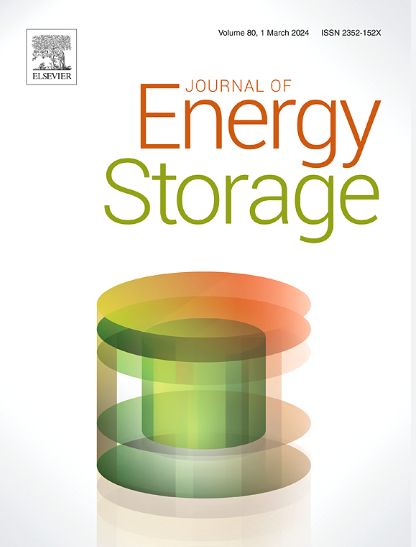An aqueous organic flow battery integrating a high-capacity hexaazatrinaphthylene anode with a phenazine anolyte for hybrid energy storage
IF 8.9
2区 工程技术
Q1 ENERGY & FUELS
引用次数: 0
Abstract
Aqueous organic redox flow batteries (AORFBs) are promising in large-scale energy storage applications due to their environmental friendliness, decoupled energy and power, high efficiency, long lifespan, and safety. However, achieving both high accessible specific capacity and reliable cycling performance simultaneously remains challenging, primarily because concentrated organic electrolytes typically suffer from reduced diffusion coefficients, diminished interfacial redox kinetics, and increased undesirable side reactions. In this study, to circumvent these limitations, we propose a novel AORFB design combining a high-capacity hexaazatrinaphthylene (HATN) anode with a phenazine anolyte, which is further paired with a highly stable Li4[Fe(CN)6] catholyte for hybrid energy storage. This innovative AORFB cell demonstrates high energy efficiency, remarkable capacity utilization and outstanding cycling stability, attributed to the fast redox kinetics and excellent stability of both HATN and BHPC, a synergistic effect between the two, and the high mass-loading of HATN at the anode. Furthermore, a prototype three-cell AORFB stack incorporating high-loading HATN anodes is successfully constructed, achieving a power density exceeding 400 mW cm−2, a high capacity utilization of 82.3 %, and excellent cycling durability with a capacity retention of 99.953 % per cycle, showcasing its potential for large-scale energy storage.
一种集成用于混合储能的高容量六氮化萘阳极和非那嗪阳极液的水相有机液流电池
水相有机氧化还原液流电池(aorfb)具有环境友好、能量与功率不耦合、高效、长寿命、安全等优点,在大规模储能领域具有广阔的应用前景。然而,同时实现高可及比容量和可靠的循环性能仍然具有挑战性,主要是因为浓缩有机电解质通常会降低扩散系数,降低界面氧化还原动力学,并增加不良副反应。在本研究中,为了克服这些限制,我们提出了一种新的orfb设计,将高容量六氮化萘(HATN)阳极与非那嗪阳极结合,并进一步与高度稳定的Li4[Fe(CN)6]阴极配对,用于混合储能。由于HATN和BHPC的快速氧化还原动力学和优异的稳定性、两者之间的协同效应以及HATN在阳极的高质量负载,这种创新的AORFB电池具有高能效、卓越的容量利用率和出色的循环稳定性。此外,成功构建了一个包含高负载HATN阳极的原型三电池AORFB堆栈,实现了超过400 mW cm - 2的功率密度,82.3%的高容量利用率,以及出色的循环耐久性,每次循环的容量保留率为99.953%,显示了其大规模储能的潜力。
本文章由计算机程序翻译,如有差异,请以英文原文为准。
求助全文
约1分钟内获得全文
求助全文
来源期刊

Journal of energy storage
Energy-Renewable Energy, Sustainability and the Environment
CiteScore
11.80
自引率
24.50%
发文量
2262
审稿时长
69 days
期刊介绍:
Journal of energy storage focusses on all aspects of energy storage, in particular systems integration, electric grid integration, modelling and analysis, novel energy storage technologies, sizing and management strategies, business models for operation of storage systems and energy storage developments worldwide.
 求助内容:
求助内容: 应助结果提醒方式:
应助结果提醒方式:


